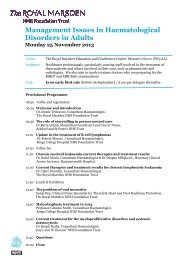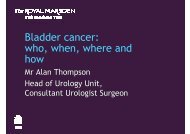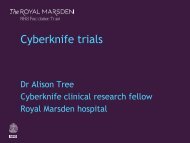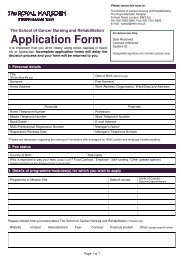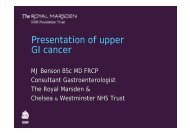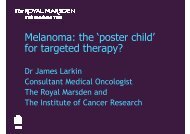David Watkins - The Royal Marsden
David Watkins - The Royal Marsden
David Watkins - The Royal Marsden
Create successful ePaper yourself
Turn your PDF publications into a flip-book with our unique Google optimized e-Paper software.
<strong>The</strong> <strong>Royal</strong> <strong>Marsden</strong><br />
Principles of chemotherapy in<br />
the management of lymphoma<br />
Dr <strong>David</strong> <strong>Watkins</strong><br />
Senior Clinical Research Fellow<br />
at the GI and Lymphoma Unit
Lymphoma outcomes<br />
100<br />
% Survival<br />
80<br />
60<br />
40<br />
one-year<br />
five-year<br />
NHL<br />
England & Wales<br />
20<br />
0<br />
1971-1980 1981-1990 1991-1999<br />
100<br />
one-year<br />
five-year<br />
% Survival<br />
80<br />
60<br />
40<br />
Hodgkin lymphoma<br />
England & Wales<br />
20<br />
0<br />
1971-80 1981-90 1991-99
<strong>The</strong> <strong>Royal</strong> <strong>Marsden</strong><br />
What has resulted in the improved lymphoma<br />
outcomes displayed in these figures <br />
1. Better diagnostic/staging procedures<br />
2. Better supportive measures (management of toxicities)<br />
3. Formation of multidisciplinary teams<br />
4. More effective cytotoxic agents<br />
5. Conformal radiotherapy
<strong>The</strong> <strong>Royal</strong> <strong>Marsden</strong><br />
What has resulted in the improved lymphoma<br />
outcomes displayed in these figures <br />
1. Better diagnostic/staging procedures<br />
Available of CT and PET imaging, Histological classification<br />
2. Better supportive measures (management of toxicities)<br />
GSCF, Antibiotics, Antiemetics, Tumour lysis, Specialist nurses<br />
3. Formation of multidisciplinary teams<br />
Medical/Clinical Oncology, Haematology, Radiology, Pathology<br />
4. More effective cytotoxic agents<br />
Limited advances ABVD and CHOP both developed in the 70’s<br />
5. Conformal radiotherapy
<strong>The</strong> <strong>Royal</strong> <strong>Marsden</strong><br />
Defining treatment strategies<br />
• Heterogeneous disease<br />
- Curative & palliative paradigms<br />
• Optimal management is heavily dependant on;<br />
- Correct pathological classification<br />
- Correct staging<br />
• Excision biopsy for ‘specialist’ histopathological evaluation<br />
- Requires assessment of tissue architecture<br />
• Histological classification is complicated….<br />
- Non-Hodgkin Lymphoma<br />
- Hodgkin Lymphoma
<strong>The</strong> <strong>Royal</strong> <strong>Marsden</strong>
<strong>The</strong> <strong>Royal</strong> <strong>Marsden</strong>
Precursor B-cell lymphoma<br />
Non-Hodgkin Lymphoma<br />
Small lymphocytic lymphoma<br />
Lymphoplasmacytic lymphoma<br />
Splenic marginal zone lymphoma<br />
Hairy cell leukaemia<br />
Plasma cell neoplasms<br />
Extranodal marginal zone B-cell lymphoma of mucosa-associated<br />
lymphoid tissue (MALT lymphoma)<br />
Nodal marginal zone B-cell lymphoma<br />
Follicular lymphoma (grades 1, 2, 3a and 3b)<br />
Diffuse follicle centre lymphoma<br />
Mantle cell lymphoma<br />
Diffuse large B-cell lymphoma<br />
Mediastinal (thymic) large B-cell lymphoma<br />
Intravascular large B-cell lymphoma<br />
Primary effusion lymphoma<br />
Burkitt lymphoma<br />
Hodgkin Lymphoma<br />
Nodular Sclerosing (Classical)<br />
Mixed-cellularity subtype<br />
Lymphocyte-rich or Lymphocytic predominance<br />
Lymphocyte depleted<br />
Unspecified<br />
Cytogenetic<br />
Abnormality<br />
t(14;18)<br />
t(8;14)<br />
Chromosomal Abnormalities<br />
Histology<br />
Follicular<br />
DLBC<br />
Burkitt<br />
lymphoma<br />
Oncogene<br />
bcl-2<br />
c-myc<br />
B-cell proliferations of<br />
uncertain malignant potential<br />
Precursor T- and NK-cell<br />
lymphomas<br />
Mature T-cell and NK-cell<br />
lymphomas<br />
Lymphomatoid granulomatosis<br />
Post-transplant lymphoproliferative disorder, polymorphic<br />
Precursor T lymphoblastic lymphoma<br />
Blastic NK-cell lymphoma<br />
T-cell prolymphocytic leukaemia<br />
T-cell large granular lymphocytic leukaemia<br />
t(11;14)<br />
t(11;18)<br />
Mantle cell<br />
lymphoma<br />
MALT<br />
lymphoma<br />
Cyclin-D1<br />
Unknown<br />
Aggressive NK-cell leukaemia<br />
Adult T-cell lymphoma/leukaemia<br />
Extranodal NK-/T-cell lymphoma, nasal type<br />
Enteropathy-type T-cell lymphoma<br />
Hepatosplenic T-cell lymphoma<br />
Subcutaneous panniculitis-like T-cell lymphoma<br />
Mycosis fungoides<br />
Peripheral T-cell lymphoma unspecified<br />
Angioimmunoblastic T-cell lymphoma<br />
Anaplastic large cell lymphoma
<strong>The</strong> <strong>Royal</strong> <strong>Marsden</strong><br />
Lymphoma classification<br />
Indolent<br />
Indolent<br />
Non-Hodgkin lymphoma<br />
– Diffuse large B cell lymphoma 31 %<br />
– Follicular lymphoma 22 %<br />
– (MALT) lymphoma; nodal/extra nodal marginal zone lymphoma 9 %<br />
– Small lymphocytic lymphoma/B-CLL 7 %<br />
– Mantle cell lymphoma 6 %<br />
– Peripheral T cell lymphoma, unspecified 4 %<br />
– Mediastinal (thymic) large B cell lymphoma 3 %<br />
– Burkitt lymphoma 2 %<br />
– Anaplastic large cell lymphoma 2 %<br />
Hodgkin lymphoma<br />
― Nodular Sclerosing<br />
– Mixed-cellularity subtype<br />
– Lymphocyte depleted<br />
– Lymphocyte-rich or Lymphocytic predominance<br />
~15% of all lymphomas
<strong>The</strong> <strong>Royal</strong> <strong>Marsden</strong><br />
Lymphoma work-up<br />
• CT – Neck, Thorax, Abdo, Pelvis<br />
• PET/CT<br />
- More sensitive than CT imaging<br />
- Role in staging and response assessement<br />
• Bone marrow aspiration and trephine<br />
• Bloods<br />
- LDH, paraproteins, β2 microglobulin, HIV, Hep B,C<br />
• Lumbar puncture<br />
- In patients considered at risk of CNS involvement
<strong>The</strong> <strong>Royal</strong> <strong>Marsden</strong><br />
Chemotherapy naming conventions<br />
Chemotherapy treatment often involves a combination of<br />
cytotoxic drugs &/or antibody therapy<br />
R-CHOP<br />
R ituximab<br />
C yclophosphamide<br />
H ydroxydaunorubicin (doxorubicin)<br />
O ncovin (vincristine)<br />
P rednisolone<br />
CVP<br />
C yclophosphamide<br />
V incristine<br />
P rednisolone<br />
Gem-P<br />
Gem Gemcitabine<br />
P latinium (Cisplatin)<br />
Methyl Prednisolone<br />
CODOX-M / IVAC<br />
C cyclophosphamide<br />
O ncovin (vincristine)<br />
Do xorubicin<br />
M ethotrexate<br />
I fosphamide<br />
V P-16 (etoposide)<br />
A ra-C (Cytarabine)<br />
ABVD<br />
A driamycin (doxorubicin)<br />
B leomycin<br />
V inblastine<br />
D acarbazine (DTIC)
<strong>The</strong> <strong>Royal</strong> <strong>Marsden</strong><br />
Treatment defined by stage and intent
<strong>The</strong> <strong>Royal</strong> <strong>Marsden</strong><br />
Curative strategy for limited stage disease<br />
Radiotherapy<br />
Chemotherapy<br />
Achieving cure with<br />
lowest long-term<br />
toxicity
<strong>The</strong> <strong>Royal</strong> <strong>Marsden</strong><br />
Curative strategy for advanced disease<br />
Radiotherapy<br />
Chemotherapy<br />
Maximising cure at<br />
expense of higher<br />
long-term toxicity
<strong>The</strong> <strong>Royal</strong> <strong>Marsden</strong><br />
Balancing Risks vs Benefits<br />
In addition to disease stage, clinical features allow an<br />
assessment of risk of treatment failure<br />
Lower Risk<br />
Risk of treatment failure<br />
Higher Risk<br />
DLBC<br />
Hodgkin<br />
Follicular<br />
International Prognostic Index<br />
Hasenclever index<br />
Follicular Lymphoma IPI
<strong>The</strong> <strong>Royal</strong> <strong>Marsden</strong><br />
Balancing Risks vs Benefits<br />
<strong>The</strong> aim is to be able to tailor treatment accordingly<br />
Lower Risk<br />
Risk of treatment failure<br />
Higher Risk<br />
DLBC<br />
R-CHOP<br />
CODOX-M/IVAC<br />
Hodgkin<br />
ABVD<br />
BEACOPP<br />
Follicular Watch and Wait<br />
R-CHOP<br />
Treatment toxicities<br />
Methods to better select patients and individualise treatment are<br />
under ongoing evaluation
<strong>The</strong> <strong>Royal</strong> <strong>Marsden</strong><br />
What is the most likely diagnosis <br />
25 yr old women presents with a 6/52 history of R<br />
cervical lymphadenopathy and 1/52 history of chest<br />
tightness. Otherwise well.<br />
1. DLBC lymphoma with pulmonary involvement<br />
2. Follicular lymphoma<br />
3. Hodgkin lymphoma with mediastinal nodal mass<br />
4. Hodgkin lymphoma with pulmonary involvement
<strong>The</strong> <strong>Royal</strong> <strong>Marsden</strong><br />
What is the most likely diagnosis <br />
25yr old women presents with a 6/52 history of R<br />
cervical lymphadenopathy and 1/52 history of chest<br />
tightness. Otherwise well.<br />
–3. Hodgkin lymphoma with mediastinal nodal mass –<br />
- Bulky stage IIA disease, ~90% 5yr survival<br />
Management Priorities<br />
1. Achieve curative outcome<br />
2. Minimise long-term morbidity<br />
3. Consider fertility preservation
<strong>The</strong> <strong>Royal</strong> <strong>Marsden</strong><br />
Hodgkin lymphoma<br />
Hodgkin lymphoma is the<br />
third most common cancer<br />
diagnosis in people aged 15-29<br />
years<br />
Chemotherapy related<br />
toxicities may significantly<br />
impact on later life<br />
Pulmonary toxicities<br />
Infertility/early menopause<br />
Bone density<br />
Cardiac toxicities<br />
Secondary malignancies<br />
Psychological impact
<strong>The</strong> <strong>Royal</strong> <strong>Marsden</strong><br />
Hodgkin lymphoma<br />
ABVD<br />
Adriamycin (doxorubicin)<br />
Bleomycin<br />
Vinblastine<br />
Dacarbazine<br />
Given by IV injection on<br />
day 1 and day 15<br />
Repeated every 28 days
<strong>The</strong> <strong>Royal</strong> <strong>Marsden</strong><br />
Hodgkin lymphoma<br />
ABVD<br />
Adriamycin (doxorubicin)<br />
Bleomycin<br />
Vinblastine<br />
Dacarbazine<br />
Given by IV injection on<br />
day 1 and day 15<br />
Repeated every 28 days<br />
Developed in the 1970’s and remains the standard of care<br />
Response usually rapid. CT imaging undertaking every 2 cycles<br />
Stage I/IIA<br />
Typical treatment would consists of 2 - 4 cycles of ABVD followed by<br />
radiotherapy to sites of disease involvement<br />
Survival rates of 90-95%<br />
Stage IIB-IV<br />
Typical treatment would consists of 6-8 cycles of ABVD and possible<br />
radiotherapy to bulky sites<br />
~30% will suffer disease relapse with 5 years survival rates of 80-90%
<strong>The</strong> <strong>Royal</strong> <strong>Marsden</strong><br />
Hodgkin lymphoma<br />
ABVD side effects<br />
– Neutropenic sepsis<br />
– Congestive cardiac failure<br />
– Pulmonary fibrosis<br />
– Thromboembolism<br />
– Infertility – ABVD carries a low risk of causing infertility<br />
– Teratogenic - Contraception<br />
– Early Menopause<br />
– Numbness or tingling in hands or feet<br />
– Fevers and chills
<strong>The</strong> <strong>Royal</strong> <strong>Marsden</strong><br />
ABVD specific toxicities<br />
Vinblastine<br />
- Peripheral and autonomic neuropathy<br />
Doxorubicin<br />
-High risk of congestive cardiomyopathy<br />
with cummulative dose of doxorubicin<br />
> 550 mg/m² (50mg/m 2 per cycle)<br />
Bleomycin<br />
- Associated with risk of pulmonary fibrosis<br />
- Risk factors: Cumulative dose<br />
Age<br />
Poor renal function<br />
Pulmonary disease<br />
Lung radiotherapy
<strong>The</strong> <strong>Royal</strong> <strong>Marsden</strong><br />
Fertility preservation<br />
Men<br />
Sperm Cryopreservation<br />
Women<br />
Egg/Embryo/ovarian tissue cryo preservation<br />
- Eggs collected after ovulation induction. This process<br />
requires 3-4 weeks.<br />
- <strong>The</strong> risk and benefits in each individual case needs to be<br />
discussed.<br />
Need to consider the potential for more intensive<br />
chemotherapy treatments if primary chemotherapy fails
<strong>The</strong> <strong>Royal</strong> <strong>Marsden</strong><br />
Other Hodgkin lymphoma regimens<br />
BEACOPP<br />
B leomycin<br />
E toposide<br />
A driamycin (doxorubicin)<br />
C yclophosphamide<br />
O ncovin (vincristine)<br />
P rocarbazine<br />
P rednisolone<br />
More effective than ABVD in high-risk patients<br />
Also more toxic, associated with<br />
- Infertility<br />
- Increase rate of secondary malignancies<br />
Concerns relating to toxicity have limited widespread use
<strong>The</strong> <strong>Royal</strong> <strong>Marsden</strong><br />
Risk of second malignancies<br />
Relative risk<br />
Time at risk<br />
Sites at risk<br />
Chemotherapy<br />
alone<br />
2.0<br />
(95%CI 1.7-2.4)<br />
Peaks 5-9 years<br />
Nil > 15 years<br />
Lung<br />
NHL<br />
Leukeamia<br />
Combined<br />
modality<br />
3.9<br />
(95%CI 3.5-4.4)<br />
0-4 years to<br />
> 20 years<br />
In addition<br />
Colon<br />
NM Skin<br />
Breast<br />
Leukaemia risk and all-malignancies risk increased strongly with<br />
number of cycles of alkylating chemotherapy
<strong>The</strong> <strong>Royal</strong> <strong>Marsden</strong><br />
Novel approaches in Hodgkin lymphoma<br />
Current standard of care<br />
6-8 cycles ABVD<br />
All patient receive<br />
therapy based on clinical<br />
factors,<br />
as a result:<br />
Proportion over-treated<br />
Proportion under-treated
<strong>The</strong> <strong>Royal</strong> <strong>Marsden</strong><br />
Novel approaches in Hodgkin lymphoma<br />
Currently under investigation: RATHL study<br />
6-8 cycles ABVD<br />
2 cycles ABVD<br />
PET<br />
scan<br />
Stage IIB-IV<br />
Hodgkin lymphoma<br />
All patient receive<br />
identical therapy,<br />
as a result:<br />
Proportion over-treated<br />
Proportion under-treated<br />
PET +ve<br />
PET -ve<br />
Randomised<br />
BEACOPP<br />
ABVD x4<br />
AVD x4
<strong>The</strong> <strong>Royal</strong> <strong>Marsden</strong><br />
R-CHOP<br />
High grade NHL / DLBC<br />
Given by IV injection<br />
with oral prednisolone<br />
R ituximab<br />
(d1-5)<br />
C yclophosphamide<br />
Repeated every 21 days<br />
H ydroxydaunorubicin (doxorubicin)<br />
O ncovin (vincristine)<br />
P rednisolone<br />
CHOP developed in the 1970’s<br />
Rituximab (anti- CD20 antibody)<br />
demonstrated benefit in 2002<br />
R-CHOP-21 current standard of care
R-CHOP specific toxicities<br />
R-CHOP R ituximab side effects<br />
C yclophosphamide<br />
H ydroxydaunorubicin (doxorubicin)<br />
O ncovin (vincristine)<br />
P rednisolone<br />
Flu-like symptoms<br />
Low blood pressure<br />
Allergic reactions<br />
Flushing<br />
Haemorrhagic cystitis<br />
Infertility / premature menopause<br />
Congestive cardiac failure<br />
Tingling in hands or feet<br />
Constipation<br />
Gastritis<br />
Increased appetite<br />
Raised blood sugar<br />
Fluid retention<br />
Behavioural changes<br />
Neutropenic sepsis<br />
Nausea and vomiting<br />
Tiredness<br />
Skin & nail changes<br />
Thromboembolism<br />
Hair loss<br />
Mucositis<br />
Altered taste<br />
Specialist nurses play a<br />
crucial role in the<br />
outpatient management<br />
of lymphoma patients
<strong>The</strong> <strong>Royal</strong> <strong>Marsden</strong><br />
How confident are you managing patients<br />
receiving cytotoxic chemotherapy<br />
1. I rarely review patients receiving chemotherapy but may on<br />
occasion contact the hospital team for advice<br />
2. I feel confident in managing patients and know when to refer to<br />
the hospital<br />
3. I am often uncomfortable reviewing patients on chemotherapy<br />
and struggle to get advice from the hospital teams<br />
4. I discuss a significant proportion of cases with the hospital team
<strong>The</strong> <strong>Royal</strong> <strong>Marsden</strong><br />
High grade NHL / DLBC lymphoma<br />
Treatment plan dependant on risk factors:<br />
- Disease bulk<br />
- International prognostic index<br />
Stage I/IIA<br />
3 cycles (R) –CHOP plus involved field radiotherapy<br />
or<br />
6-8 cycles R-CHOP<br />
Stage II-IV<br />
6-8 cycles R-CHOP +/- radiotherapy<br />
Possible intrathecal chemotherapy for CNS prophylaxis
<strong>The</strong> <strong>Royal</strong> <strong>Marsden</strong><br />
Developments in DLBC lymphoma<br />
Delivery of CHOP chemotherapy every 14 days has been<br />
shown to be more effective than delivery every 21 days<br />
It is not currently known if R-CHOP 14 is better than R-<br />
CHOP 21<br />
Stage IIB - IV<br />
Randomise<br />
6x<br />
R-CHOP-14<br />
8x<br />
R-CHOP-21
<strong>The</strong> <strong>Royal</strong> <strong>Marsden</strong><br />
Risk adjusted treatment strategies in DLBC<br />
Studies are examining the use of more intensive chemotherapy regimens in<br />
patients at higher risk for relapse<br />
Aim to reduce relapse risk but only expose a limited number of patients to<br />
increased toxicity<br />
International prognostic index<br />
Age (>60)<br />
Ann Arbor stage<br />
(III/IV)<br />
Performance Status (≥2)<br />
Serum LDH<br />
(>ULN)<br />
Number of extranodal sites (>1)<br />
Lower risk<br />
Stage II - IV<br />
Higher risk patients<br />
Stage III/IV<br />
6-8x<br />
R-CHOP-21<br />
R- CODOX-M<br />
IVAC
<strong>The</strong> <strong>Royal</strong> <strong>Marsden</strong><br />
Management of relapsed disease<br />
– Bone marrow transplantation often considered<br />
– Non-cross resistant chemotherapy regimens may be<br />
utilised to re-induced remission prior to bone marrow<br />
transplant<br />
– Platinum based<br />
- Gem- P (gemcitabine, cisplatin, methylprednisolone)<br />
- ESHAP (etoposide, methylprednisolone, cytarabine, cisplatin)<br />
- DHAP (dexamethasone, cisplatin, cytarabine)<br />
– Ifosfamide based<br />
- IVE (Ifosfamide, etoposide, epirubicin)<br />
- ICE (ifosfamide, etoposide, carboplatin)<br />
- IVAC (ifosfamide, etoposide, cytarabine)
<strong>The</strong> <strong>Royal</strong> <strong>Marsden</strong><br />
Low Grade NHL<br />
– Considered incurable (some exclusions; stage 1 and MALT)<br />
– Often indolent behaviour with slowly progressing disease and<br />
median survival ~10-12 years<br />
– May develop transformation to high-grade disease<br />
– Treatment of low-grade lymphoma often less intense including<br />
observation alone<br />
– Patients will receive multiple lines of therapy during the course<br />
of their lives. Treatment aims;<br />
- Delay symptomatic decline (maximise PFS)<br />
- Minimise treatment morbidity (ie hospital stays)
<strong>The</strong> <strong>Royal</strong> <strong>Marsden</strong><br />
Treating follicular lymphoma – systemic therapy<br />
Common regimens<br />
- R-CVP<br />
1 st line NICE guidance<br />
Symptomatic stage III/IV disease<br />
- R-CHOP + maintenance rituximab<br />
- Rituximab<br />
- Chlorambucil +/- rituximab<br />
- FC-R (fludarabine, cyclophosphamide & rituximab)<br />
Radioimmunotherapy – Zevalin (Ibritumomab tiuxetan)<br />
Allogeneic transplantation<br />
- Can produce durable remissions in multiply relapsed patients
<strong>The</strong> <strong>Royal</strong> <strong>Marsden</strong><br />
Maintenance rituximab in follicular lymphoma<br />
<strong>The</strong> use of maintenance rituximab significantly delays the time to<br />
disease progression<br />
2 nd Line<br />
Rituximab intravenously<br />
once every 3 months<br />
until relapse or for a<br />
maximum of 2 years<br />
NICE approved 2008<br />
1 st Line<br />
Rituximab intravenously<br />
once every 2 months<br />
until relapse or for a<br />
maximum of 2 years<br />
0 6 12 18 24 30 36 42 48 54 60
<strong>The</strong> <strong>Royal</strong> <strong>Marsden</strong><br />
Rituximab<br />
Which of the following statements regarding rituximab<br />
is false<br />
1. Rituximab improves survival in DLBC lymphoma<br />
2. Rituximab is associated with a depletion of B cells<br />
3. Rituximab can cause neutropenia<br />
4. Patients on rituximab should not receive the seasonal<br />
flu vaccine
Summary<br />
<br />
<br />
<br />
Rituximab has had a major influence on the treatment of low- and<br />
high-grade NHL<br />
Current studies are examining the optimal use of chemotherapy<br />
regimens attempting to limits patients exposure to excess toxicity<br />
- Molecular predictors<br />
Novel targeted agents continue to be evaluated<br />
- Temsirolimus: Targets mTOR, a protein involved in cell growth and proliferation<br />
- Brentuximab: Anti- CD30 antibody, a protein expressed in Hodgkin<br />
lymphoma and anaplastic large cell lymphoma<br />
- Bendamustine: Conventional cytotoxic agent showing high response rates<br />
in indolent and mantle cell lymphoma<br />
- Lenolidomide: A derivative of thalidomide approved to treat myeloma under<br />
evaluation in lymphoma.






